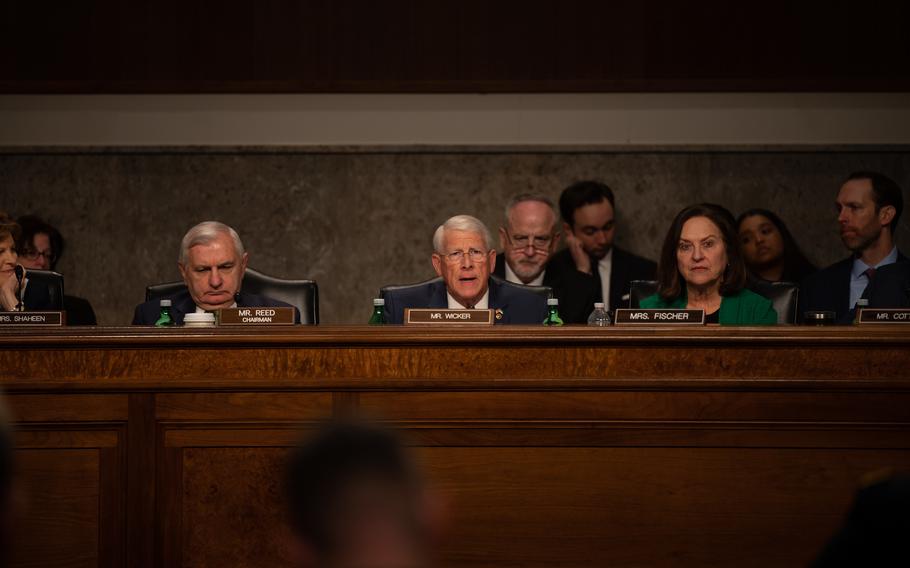
Senate Armed Services Committee hearing at the Dirksen Senate Office Building in Washington, D.C., on March 16, 2023. (John Wright/U.S. Air Force)
WASHINGTON — Top lawmakers on the Senate Armed Services Committee said Thursday that they might raise the Army’s budget for fiscal 2024, criticizing the Pentagon’s proposed spending plan for the military’s largest service as insufficient.
Sens. Jack Reed, D-R.I., the committee chairman, and Roger Wicker, R-Miss., the panel’s top Republican, said they were worried the $185 billion Army budget requested by the Pentagon did not keep pace with inflation or meet the service’s needs as it contends with the most dangerous security environment since World War II.
Reed noted the Defense Department’s budget for the next fiscal year, which begins Oct. 1, marks the fourth straight year that the Army’s spending plan had remained at roughly the same amount. The Army has seen its funding “essentially plateau,” even as every other service has benefitted from significant increases, he said.
“Understandably, the department is focused on the pacing threat in the Indo-Pacific, where the nature of competition relies heavily on our nation’s sea and air strength. However, I am concerned that inadequate investment in the United States’ primary land component may create vulnerabilities,” Reed said. “We risk the Army’s combat credibility if we do not provide it with the resources it needs to continue full modernization.”
Wicker described the budget request as a “disservice” to the Army. He said the spending plan represents a 2% cut compared to last year, when accounting for inflation, and the impact of that cut will be even more severe amid rapidly increasing personnel costs. The Pentagon is asking for a 5.2% pay raise for troops and the Defense Department’s civilian employees.
“I am confident my colleagues on a bipartisan basis, again, will join me to correct this inadequate budget and make sure the Army has the right resources to confront the nation’s current and future challenges,” Wicker said.
Congress last year added $45 billion to the Defense Department’s budget request.
Wicker pointed to the Army’s nearly $2 billion “unfunded priorities” list, a wish list mandated by Congress, as evidence of how much more funding is needed. The list calls for, among other things, additional money to upgrade Abrams tanks and expanding exercises and activities in the Indo-Pacific region, where the U.S. military is working to deter China’s aggression.
Reed said the Army has a critical role to play in the region by providing long-range weapons and ground forces, training and experimenting with partners and allies, supporting logistics and positioning stocks of equipment.
The Army’s top leaders testifying about the budget before the Senate committee Thursday said the service is trying to strike a balance between competing priorities and would welcome additional funds.
“Certainly, if Congress were to give the Army more money, I think we would look at investments in the INDOPACOM region,” Amy Secretary Christine Wormuth said.
The Army is also trying to find more dollars for infrastructure projects as it works to renovate and build new barracks, she said. The service is investing $3.5 million to remediate toxic mold recently found in 2,100 Army buildings and plans to spend $1 billion per year on barracks through 2030, she said.
“The challenge we have is we have such an enormous inventory of barracks that we’re not able to rebuild all of them in one to two years, as we might like, and still be able to invest in new weapon systems and invest in other new initiatives we need to do,” Wormuth said.
Sen. Kirsten Gillibrand, D-N.Y., said the Army’s proposed budget would only pay for five new barracks.
Gen. James McConville, the Army’s chief of staff, acknowledged the concern from senators and said the service was still modernizing and pursuing its top objectives within fixed financial parameters.
“Some would argue that you cannot transform an army without having 3% to 5% real growth [but] that's what we are trying to do,” he said. “We're trying to do the best we can with what we have and deliver the best Army we can do with the resources we get.”